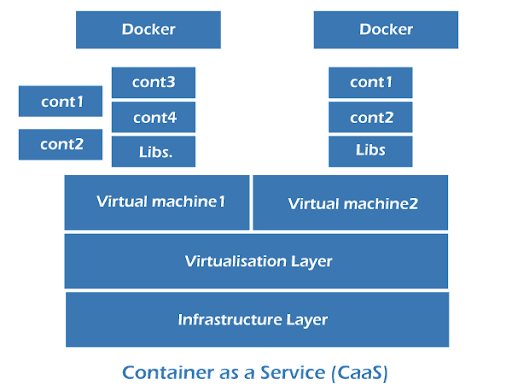In cloud computing, Container as a Service (CaaS) starts, stops, manages, scales, hosts, and deploys containerized software packages. The entire infrastructure runs on cloud machines and network routing systems. A web portal interface or application programming interface (API) calls are used to access the service.
Contents
What is CaaS (Container as a service)?
Containers are software packages designed to run in any environment. They are usable units of code packaged with other dependencies like frameworks, system libraries, system tools, runtime, and settings. So, containers can create a virtual operating system environment and run from anywhere, whether it’s on your laptop, a public cloud, or a private data center.

A container as a service (CaaS) is a cloud service capable of deploying and hosting containerized workloads across different cloud environments. CaaS can be implemented across hybrid cloud and multi-cloud environments as they don’t stick to one programming language or code stack. The container as a service platform offers consumers an operational framework to access the service. A few big providers in the industry are Amazon Fargate, Amazon Elastic Container Service (ECS), and Azure Container Instances (ACI).
Businesses need the confidence to run their applications flawlessly in the future. Containerized approach ensures consistent operations of your applications with all their dependencies from anywhere. Using CaaS software, developers can create containerized apps that are scalable and secure. The productivity of your development and IT staff increases manifold due to the automation provided by CaaS. It keeps the ecosystem up-to-date and makes your operational pipeline work better.
How does CaaS work in Cloud Computing?
In cloud computing, users use CaaS to upload, build, run, and manage container-based apps in the cloud. The communication with the platform is done through API calls or a graphical user interface (GUI).
Orchestration tools, which manage complex container architecture, are at the heart of every CaaS platform. Container orchestration helps enterprises deploy and supervise hundreds or even thousands of containers and hosts. Additionally, it helps to install the same application across multiple environments without repurposing it.
Microservices in containers give your applications a self-managing execution environment and a robust deployment unit. Besides, orchestrating network, storage, and security becomes super easy.
Why is CaaS important?
IT teams are responsible for managing applications and servers. CaaS helps enterprise development teams deal with complicated tasks and workflows more easily because doing so manually is a tedious approach.
CaaS deploys innovative solutions in the cloud and accelerates the software development process. Software development teams release products quicker while reducing bottlenecks, inefficient waste processes, and resource consumption.
Among the features and benefits of CAAS in cloud computing are:
- Portability: Your business applications run independently of the underlying infrastructure as the containers are packaged with all the libraries, configuration files, and dependencies. Container-based apps can be deployed in multiple environments, including public and private clouds. Besides, switching to different cloud environments does not throw the applications off.
- Efficiency: Containers run on a shared operating environment and need fewer files to run the applications. They are lightweight to start and feed on the bare minimum of computing resources. A single server can manage several containers, which means more cost savings.
- Scalability: Container expansion is driven horizontally. When needed, users can add additional containers within the same cluster. Several identical clusters control peak workloads when required. The ability to use and run only what is needed optimizes cost and resource utilization.
What are the limitations of CaaS?
Although containers and microservices go hand-in-hand, it’s not necessary to deploy microservices using containers. Containers may complicate operations, so it’s crucial to build a comprehensive strategy first. Some of the most significant limitations of CaaS are
- Security Issues: Although containers are considered safer than virtual machines, they do carry certain risk factors. If targeted specifically, CaaS platforms are vulnerable to unauthorized access and attacks. Even if containers are platform independent, they share kernel dependencies with the underlying operating system. Moreover, when used on the cloud, the risk shoots up.
- Performance Limitations: Containers don’t run directly on barebones computers. A layer of the operating system and its kernels stand between the bare metal and containers. As a result, the added layer ends up inducing performance lag. The losses soar significantly when we add the networking losses of the containers too. Inevitably, superior hardware doesn’t always convert into superior performance, and enterprises have to bite the bullet.
- Rise in Cost: Organizations welcome CaaS with a promise to reduce expenses. But as containers are easy to launch, developers often forget about reusing them. Over time, as new containers keep adding up, the cloud ends up with a gigantic container mess. The clutter consumes a substantial amount of bandwidth and storage, leading to increased cloud bills for organizations.
Containers vs. Virtual Machines
Both containers and virtual machines are used to deploy multiple independent services on a single platform. But they vary when it comes to characteristics and operations.
| Virtual Machines (VM) | Containers |
| The hypervisor, or emulating software, runs between the hardware and the virtual machine. The hypervisor manages physical resources and enables virtualization. | The host operating system sits in between the physical server and the container. A common operating system ensures higher portability and agility than virtual machines. |
| VM allows you to install and control other software virtually without installing them physically on the computer | Container is a usable piece of code that allows you to deploy isolated functionalities of an application |
| VM is big and takes minutes to run | Containers are smaller in size, take less memory, and start-up in seconds |
How is CaaS different from PaaS, IaaS, and FaaS?
- CaaS vs. FaaS: FaaS is often preferred by developers who want to churn out new applications quickly without worrying about infrastructure. Language runtime and system dependencies are managed by the provider, unlike in CaaS, where developers take charge of the configuration.
CaaS is more flexible than FaaS when running advanced applications that require specific system-level requirements. - CaaS vs. PaaS: PaaS is a platform used to develop and run applications without installing hardware or software locally. The service provider hosts, deploys, and executes business apps for IT professionals. Google App Engine is a fine example.
CaaS is a container platform where developers need to allocate space for packaging and execution. - CaaS vs. IaaS: IaaS is more useful when working on customer-centric web applications with data warehousing, development, workload diversity, and testing, whereas, CaaS is preferred when the development team wants more flexibility over application components. Containers can handle complex operations.
- Small to medium-sized businesses prefer IaaS as it offers better scalability than CaaS.
FAQs
Q1. What are containers used for?
Containers are used for packaging software codes along with all the necessary dependencies to run in any environment.
Q2. What are PaaS, IaaS, and FaaS?
PaaS stands for “platform as a service,” IaaS for “infrastructure as a service,” and FaaS for “function as a service.”
Q3. How does containerization differ from virtualization?
Containerization allows you to run multiple applications against the same operating system on a single server, whereas with virtualization, you run multiple operating systems on a single physical server.
Q4. What applications and services are commonly containerized?
Distributed applications and microservices commonly use containerization.













